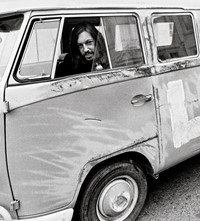Bringing together more than 100 pictures by Dennis Hopper – many of them never published before – new book In Dreams explores the late actor’s 1960s photography
- TextMiss Rosen
Dennis Hopper was only 19 when his friend and Rebel Without a Cause co-star James Dean died in 1955. Deeply affected by this loss, the young actor became insolent, refusing to play by Hollywood’s rules, and was soon blacklisted from the industry.
But Hopper didn’t need to be on the silver screen to express himself; he soon found solace in photography, using the camera to engage with the world. Eschewing a careerist approach, Hopper made photographs to hone his eye, finding pleasure in the act of looking at the world as it unfolded in ways big and small throughout the 1960s.
In the new book, Dennis Hopper: In Dreams, editor Michael Schmelling presents more than 100 photographs, most never published before, that present Hopper’s evolution as an artist. Working across genres including documentary, fashion, music, fine art, and abstract photography, Hopper’s work provides poignant insight into his daily life between 1961 and 1967.
“This is a pivotal moment in Hopper’s life,” says Schmelling. “He is not acting as much. Instead he was spending time with artists like Andy Warhol, Ed Ruscha, Joseph Albers, and Jean Tinguely as a friend, collector, and participant. I think he saw himself as a peer as he was coming into his own. Photography became the stepping stone that allowed him to develop his creative eye, which finds the fullest expression of his artistic vision came in his films, like Easy Rider.”
In the years before Hopper would make his triumphant return to the screen, subverting Hollywood tropes and spectacularly capturing the zeitgeist, photography allowed him to be attuned to the radical shifts taking place in 1960s America.
Though he spent time at the Factory, palled around with William Claxton and Peggy Moffitt, and hung out with his soon-to-be co-star Peter Fonda (who sadly died in August), Hopper eschewed his celebrity, preferring to position himself as an observer of the times in which he lived. Whether photographing a riot on Sunset Boulevard or a couple sitting in a kissing booth, Hopper used the camera to be in the moment and keep his finger on the pulse.
Schmelling says, “I wanted to encompass every piece of what Hopper was seeing in southern California in the 1960s: movie sets, travelling, domestic scenes with his wife, the actress Brooke Hayward, or a stray shot of hands writing a letter at home – the things that got to the heart of what and how he saw.”

Dennis Hopper: In Dreams is out today, published by Damiani.















